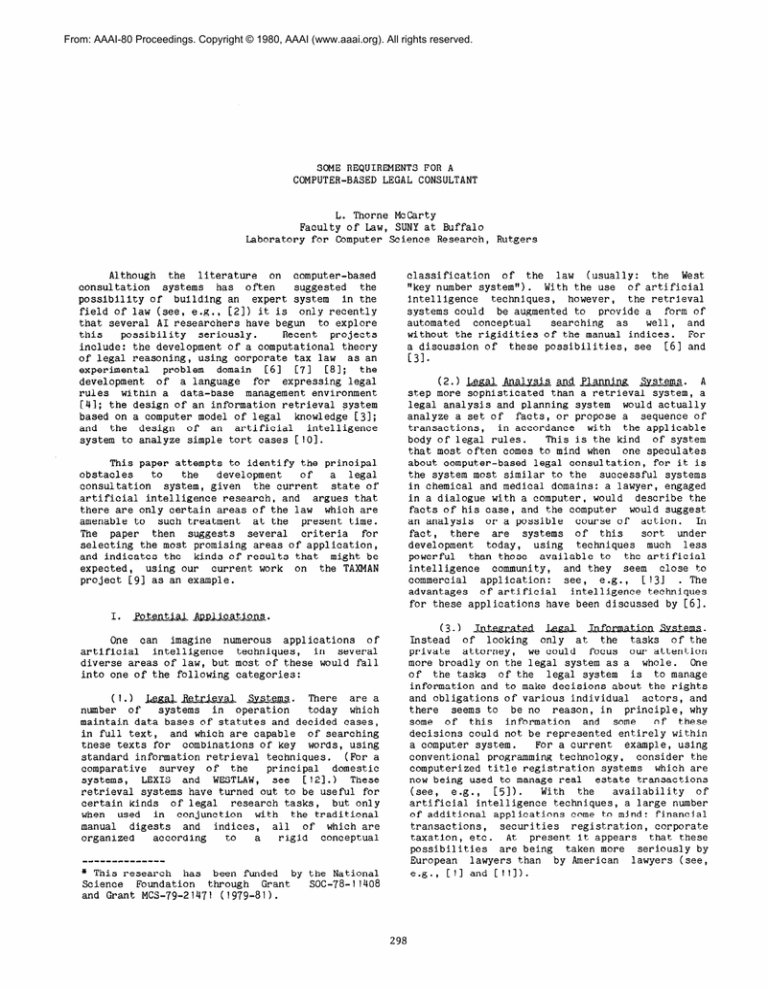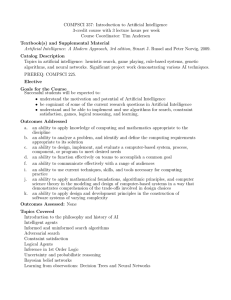
From: AAAI-80 Proceedings. Copyright © 1980, AAAI (www.aaai.org). All rights reserved.
SOME REQUIREMENTSFOR A
COMPUTER-BASEDLEGAL CONSULTANT
L. Thorne McCarty
Faculty
of Law, SUNY at Buffalo
Laboratory
for Computer Science
Research,
Although
the
literature
on
computer-based
systems
has
often
the
consultation
suggested
possibility
of
building
an
expert
system
in the
field
of law (see,
e.g.,
[2])
it is
only recently
that several
AI researchers
have begun
to explore
this
possibility
seriously.
Recent
projects
include:
the development
of a computational
theory
of legal
reasoning,
using corporate
tax law
as an
experimental
problem
domain
C61
C73
C81;
the
development
of
a language
for
expressing
legal
rules
within
a data-base
management environment
[Y];
the design
of an information
retrieval
system
based on a computer model of legal
knowledge
[ 31;
intelligence
and
the
design
of
an
artificial
system to analyze
simple
tort
cases
[lo].
This paper attempts
to identify
the principal
obstacles
to
the
development
of
a
legal
consultation
system,
given
the current
state
of
artificial
intelligence
research,
and
argues
that
there are only certain
areas of the law
which are
amenable
to
such treatment
at the
present
time.
The
paper
then
suggests
several
criteria
for
selecting
the most promising
areas of application,
and indicates
the
kinds of results
that
might be
current
work
on
the TAXMAN
expected,
using our
project
[q] as an example.
I.
Poter&i&
Rutgers
classification
of
the
law
(usually:
the
West
of artificial
"key number systemV1).
With the use
intelligence
techniques,
the retrieval
however,
systems
could
be augmented to
provide
a
form of
automated
conceptual
searching
as
well,
and
without
the rigidities
of the manual indices.
For
[6]
and
a discussion
of
these
possibilities,
see
c31.
(2.)
I&g,& Analvsis
and Planni.
Svstems.
A
step more sophisticated
than a retrieval
system,
a
legal
analysis
and planning
system
would actually
analyze
a set of
facts,
or propose
a sequence
of
transactions,
in accordance
with
the applicable
This is the kind
of system
body of legal
rules.
that most often
comes to mind when one speculates
about computer-based
legal
consultation,
for it is
the system most similar
to the
successful
systems
in chemical
and medical
domains:
a lawyer,
engaged
in a dialogue
with a computer,
would
describe
the
facts
of his case,
and the computer
would suggest
course
of
action.
In
an analysis
or a possible
there
are
systems
of
this
sort
under
fact,
using
techniques
much less
development
today,
than those
available
to
the artificial
powerful
close
to
intelligence
seem
community,
and they
commercial
application:
see,
e.g.,
[I31
. The
of artificial
intelligence
techniques
advantages
for these applications
have been discussed
by [ 61.
&nlications.
One can
imagine
numerous
applications
of
artificial
intelligence
techniques,
in
several
diverse
areas of law, but most of these
would fall
into one of the following
categories:
(I.)
m-al
Svstema.
There
are a
systems
in
operation
today
which
number
of
maintain
data bases of statutes
and decided
cases,
and which are capable
of searching
in full
text,
these
texts
for
combinations
of key
words,
using
standard
information
retrieval
techniques.
(For a
of
the
domestic
comparative
survey
principal
systems,
LEXIS and
WESTLAW, see
cf21.1
These
retrieval
systems
have turned out to be useful
for
certain
kinds
of legal
research
tasks,
but only
in
conjunction
with
the traditional
when used
manual
digests
and
indices,
of
which are
all
rigid
conceptual
organized
according
to
a
* This research
has
been funded
by the National
SOC-78- 1 1408
Science
Foundation
through
Grant
and Grant MCS-79-21471
(1979-81).
(3.)
Integrated
u
Information
Svstems.
of
looking
only
at
the
tasks
of the
Instead
our attention
private
attorney,
we could
focus
more broadly
on the legal
system as a whole.
One
of the
legal
system
is
to manage
of
the tasks
information
and to make decisions
about the rights
and obligations
of various
individual
actors,
and
there
seems to
be no
reason,
in
principle,
why
of
these
of
this
information
some
some
and
decisions
could not be represented
entirely
within
For a current
example,
using
a computer
system.
conventional
programming
technology,
consider
the
which are
computerized
title
registration
systems
estate
transactions
now being
used to manage real
availability
of
(see,
e.g.,
With
the
c511.
artificial
intelligence
techniques,
a large
number
of additional
applications
come to mind: financial
transactions,
securities
registration,
corporate
taxation,
etc.
At present
it appears
that these
possibilities
are being
taken more
seriously
by
European
lawyers
than
by American
lawyers
(see,
e.g.,
[II and [Ill).
the
potential
role
of
If
we consider
artificial
intelligence
techniques
in all of these
a basic
paradigm
emerges.
A
applications,
consul tat ion
system
must
computer-based
legal
represent
the 11facts11
of a case at
a comfortable
it must
represent
the
level
of
abstraction,
and
The
the chosen
area
of
application.
I11 awl1 in
“concepts”
and
“lawl’ would consist
of a system of
ltrulesl’ with
the following
characteristics
: (a. 1
relatively
abstract,
that
is,
they
they would be
would subsume large
classes
of lower-level
factual
descriptions;
and
(b. ) they would
have normative
they would
specify
which
implications,
that is,
actions
were
actions
were
permitted
and
which
Legal anal ysi 3,
obligatory
in a given
situation.
in its
simplest
form,
would then be a process
of
Put
this
way,
applying
the lllawll to the “facts.” .
the paradigm
seems to be an ideal
candidate
for an
approach:
“facts11
intelligence
the
artificial
would
be
represented
in
a lower-level
semantic
be represented
network,
perhaps ; the ltlawll would
in
a higher-level
semantic
description
; and the
process
of legal
analysis
would be
represented
by
a pattern-matching
routine.
II.
Possible
mroaches.
Since the representation
problems
for a legal
consul tation
system
are
so
difficult,
it
is
start
with
the
“simplestl’
possible
tempting
to
1 egal issue 3,
such as the
subject
matter
of the
first-year
law school
courses.
We might therefore
be
tempted
to
investigate
assault
and battery
cases
from
the first-year
torts
course
[ lOI, or
offer
and
acceptance
cases
from
the first-year
contracts
tour se .
these cases
are ltsimplelV
But
for law students
primarily
because
they
draw upon
ordinary
human experience,
and this
is precisely
so difficult
for
an artificial
what
makes them
intelligence
system.
To understand
tort
cases,
we
must understand
all the ways in which human beings
can be injured,
intentionally
and unintentionally,
without
mental 1 y
and
physically
,
with
and
To understand
contract
cases,
we
justification.
must understand
the expectations
of real
people
in
concrete
business
situations,
and
the ambiguities
of
human language
in
expressing
particular
contractual
intentions.
If we abstract
away these
entirely
the
central
details,
we
will
miss
features
of legal
reasoning,
and
our consultation
systems
will
tend to produce
only the more trivial
results.
The
difficult
problems
with
this paradigm,
In the
however,
are the representation
problems.
systems,
in
other
knowledge-based
existing
domains,
the representation
of the llfactsll
and the
relatively
straight
forward.
In
I11 awl1 has
been
DENDRAL, for example,
the ground-level
description
of
all
possible
chemical
strut tures
could
be
in a simple
graphical
notation,
and
represented
the rules
for splitting
these
structures
in a mass
be -represented
as
simple
spectrograph
coul d
operations
on the links
of the graphs.
In MYCIN,
the basic
facts
of a case could
be
represented
as
a set of features
listing
the presence
or absence
and the
results
of certain
of
certain
symptoms
and the diagnostic
laboratory
tests,
rules
could
then
be represented
as a
probabilistic
judgment
or test
implied
a
symptom
result
that
a given
certain
disease.
Paradoxically,
the
cases
that
are
most.
tractable
for an
artificial
intelligence
system
are those cases,
usually
involving
commercial
and
corporate
matters,
which
a lawyer
finds
most
There is a simple
reason
why this
is so.
complex .
industrialized
A mature
1 egal
system
in
an
democracy
i a composed of
many levels
of legal
abstractions:
the
law initially
defines
llrightsll
in terms
0 f concrete
objects
and
ordinary
human
treated
as
actions
, but
these rights
are
then
I1 themselves,
to further
llobjects
and made subject
;
this
process
of
human llactionsll
by
repeating
reification
body
of
many times,
a complex
commercial
law can be developed.
Because
of their
technical
complexity,
the
legal
rules
at
the top
levels
of this
conceptual
hierarchy
are difficult
for most lawyers
to comprehend,
but this
would be
no obstacle
for an artificial
intelligence
system.
commercial
fact,
are
The
abstractions,
in
artificial
and formal
systems
themselves,
drained
of much of the content
of the ordinary
world;
and
because
of the commercial
pressures
for precision
and uniformity,
they are,
by legal
standards,
well
structured.
A reasonable
strategy
for developing
a computer-based
legal
consul tation
system,
then,
would be to start
here.
the
facts
of
a
legal
case
By contrast,
of daily
involve
al 1 the complexities
typically
life :
human
actions,
beliefs,
intentions,
motivations,
etc. , in a world of
ordinary
objects
houses
and
automobil es,
and
complex
like
institutions
like
businesses
and courts.
Even if
a
particular
the
facts
of
case
could
be
represented
in
a computer
system,
the
rules
would
often
be
problematical.
Some
themselves
have a
rules,
usually
those
embodied
in statutes,
strut ture , and
this
makes them
precise
logical
artificial
intelligence
the existing
amenable
to
techniques.
But it is a commonplace
among lawyers
that the
most important
legal
rules
do
not have
this
form at all:
instead
they are said to have an
ltopen
texture”;
their
boundaries
are
not fixed,
but are llconstruc ted”
and ltmodifiedll
as
they are
to
particular
fat tual
situations.
A
applied
sophisticated
legal
consul tation
system
would not
to ignore
these complexities,
be able
but would
have to address
them directly.-
This is the strategy
we have followed
in the
C61
[7]
.
The
TAXMAN system
TAXMAN project
operates
in the field
of corporate
tax
law, which
hierarchy
of
is
very
near
the
apex
of
the
commercial
abstractions.
The basic
11facts11
of a
corporate
tax case can be captured
in a relatively
straightforward
representation:
corporations
issue
securities,
transfer
property,
distribute
etc.
Below this
level
there
dividends,
is an
representation
of
the
meaning
expanded
of
a
security
interest
in terms of its component
rights
obligations:
the
owners of
the shares
of a
and
common stock,
for example,
have certain
rights
to
299
the "earnings",
the "assets",
and the llcontrol"
of
Above this
level
there
is the
the corporation.
which
classify
lllawll :
the
statutory
rules
transactions
as taxable
or
nontaxable,
ordinary
income or capital
gains,
dividend
distributions
or
stock
redemptions,
etc.
Although
these
rules
are
certainly
complex,
the
underlying
representations
concluded
from our
are
manageable,
and
we have
earlier
work
that the
construction
of
an expert
consultation
system in this
area of the law
is a
feasible
proposition
C61 .
In our
current
work [7] we are
taking
this
model one step
further,
in an attempt
to account
texture"
of legal
concepts
and the
for the "open
process
by which a legal
concept
is "constructed"
and "modified"
during
the
course
of
an argument
over a contested
case.
In many areas of
the law
this would be
an impossible
task:
the complexity
of the
representation
would be
overwhelming,
and
the
structural
and
dynamic
properties
of
the
concepts
would be
obscured.
But in the
world of
corporate
abstractions
the
task
appears
to be
feasible.
Looking at
a series
of
corporate
tax
cases
before
the United
States
Supreme
Court in
have
been
able to
1920's
and
19301s,
we
the
construct
a model
of
the
concept
of "taxable
income"
as it
appeared
to the lawyers
and judges
at the
time (see [9])
. Although
the
concept
is
sometimes
represented
as a "logicalfl
pattern
which
can be "matched"
to a lower-level
semantic
network
(we call
this
a -ical
temblate
structure),
the
more important
representation
for the
process
of
legal
analysis
consists
of a prototvpe
structure
and a sequence
of deformations
of
the prototype.
We are currently
involved
in an
implementation
of
these
ideas,
and
we will
describe
them
in detail
in a future
paper (for
an initial
description
of
We believe
that
the implementation,
see
[81).
the
"prototype-plus-deformation"
structure
is an
essential
component
of a
system of
legal
rules,
and that it ought
to play an important
role
in a
sophisticated
legal
consultation
system.
REFERENCES
T:11 Bing,
J., and Harvold,
Information
Svstems
Oslo,
1977).
[2]
[4]
and
Headrick,
T.E.,
"Some
Artificial
Intelligence
and
23 Stanford
ti
Review 40-
Jones,
S., Mason, P., and Stamper,
R., "LEGOL
2.0:
A Relational
Specification
Language for
Complex Rules, )1 4 Information
Svstems 293-305
( 1979).
[5] Maggs,
P.B.,
System,"
22
369-91
(1973).
"Automating
the
American
Universitv
C63 McCarty,
L.T.,
flReflections
Artificial
Experiment
in
Legal Reasoning,11
90 Harvard
(1977).
Land
Title
Law Review
on
TAXMAN: An
Intelligence
and
&
Review 837-93
"The TAXMAN Project:
[7] McCarty,
L.T.,
Towards a
Cognitive
Theory
of Legal
Argument,"
in B.
Niblett,
ed.,
Computer
&g&
&
Legal
&gl&@Jg
(Cambridge
University
Press,
forthcoming
1980).
183 McCarty,
L.T.,
and
Sridharan,
N.S.,
"The
Representation
of an Evolving
System
of Legal
Concepts:
I.
Logical
Templates,"
in
Proceedings.
Third National
Conference
of the
Canadian Societv
for
Computational
Studies
of
AIntelligence,
Victoria,
British
Columbia,
May
14-16, 1980.
Prosbects.
This paper has emphasized
the difficulties
in
constructing
a computer-based
legal
consultation
system,
but
it has
also
suggested
some feasible
approaches.
The
main
difficulty
is
the
representation
problem:
the factual
situations
in
problem
domain
involve
complex
human
a legal
and the
most important
legal
actions,
rules
tend
to contain
the most amorphous and
malleable
legal
concepts.
By selecting
legal
problems
from the
commercial
and corporate
areas,
however,
we can
construct
a representation
of the legally
relevant
facts
without
having
to model
the
entire
human
world,
and we can begin
to develop
the necessary
structures
for
the representation
of
the higherlevel
legal
rules.
We have had some
success
with
this
strategy
in
the
TAXMAN project,
and
we
believe
it can be applied
elsewhere
as well.
m
[3] Hafner,
C., "An Information
Retrieval
System
Based on a Computer Model of Legal Knowledge,"
Ph.D.
Dissertation,
University
of
Michigan
(1978).
[9]
III.
Buchanan,
B.G.,
Speculation
About
Legal Reasoning,"
( 1970).
T., &Q&- Decisions
(Universitetsforlaget,
McCarty,
L-T.,
Sridharan,
B.C.,
"The
Implementation
Experiment
in
Artificial
Legal Reasoning,"
Report
for
Computer
Science
University
(1979).
N-S.,
and Sangster,
of
TAXMAN II: An
Intelligence
and
LRP-TR-2,
Laboratory
Research,
Rutgers
[ IO1 Meldman,
J.A.,
"A
Preliminary
Study
in
Computer-Aided
Analysis,"
Legal
Ph.D.
Dissertation,
Massachusetts
Institute
of
Technology,
Technical
Report
No. MAC-TR-157
(November,
1975).
[ 111 Seipel,
Stockholm,
[I21
Sprowl,
Legal
1976).
El31
Sprowl,
Process:
Statutes
American
300
P.,
Computing
1977).
J.A.,
A Manual
for
Research
(American
&
(LiberForlag,
Commuter-Assisted
Bar
Foundation,
J.A.
"Automating
the Legal Reasoning
A Computer that Uses
Regulations
and
to
Draft
Legal
Documents,"
1979
&
Foundation
Research
Journal
l-81.







